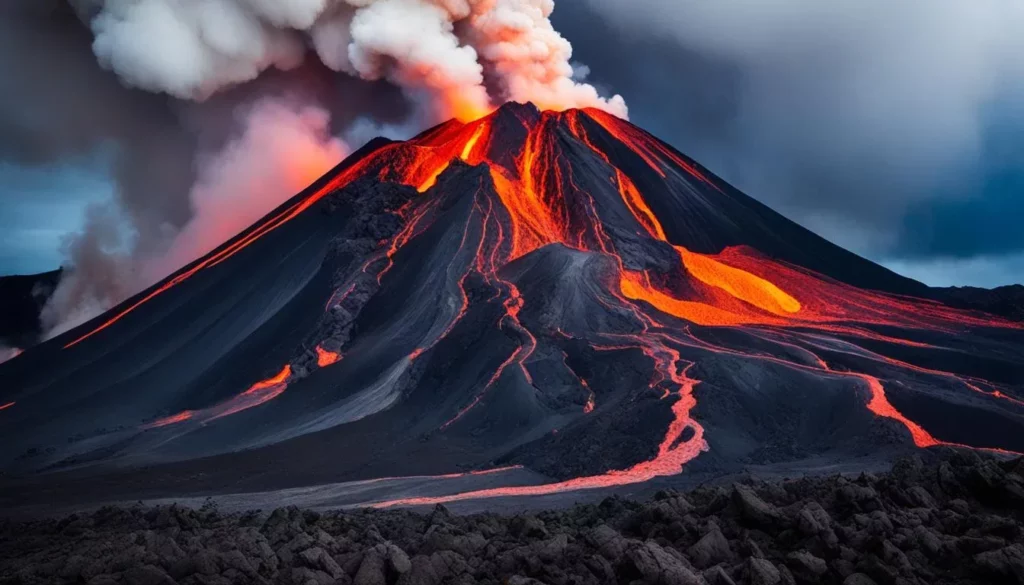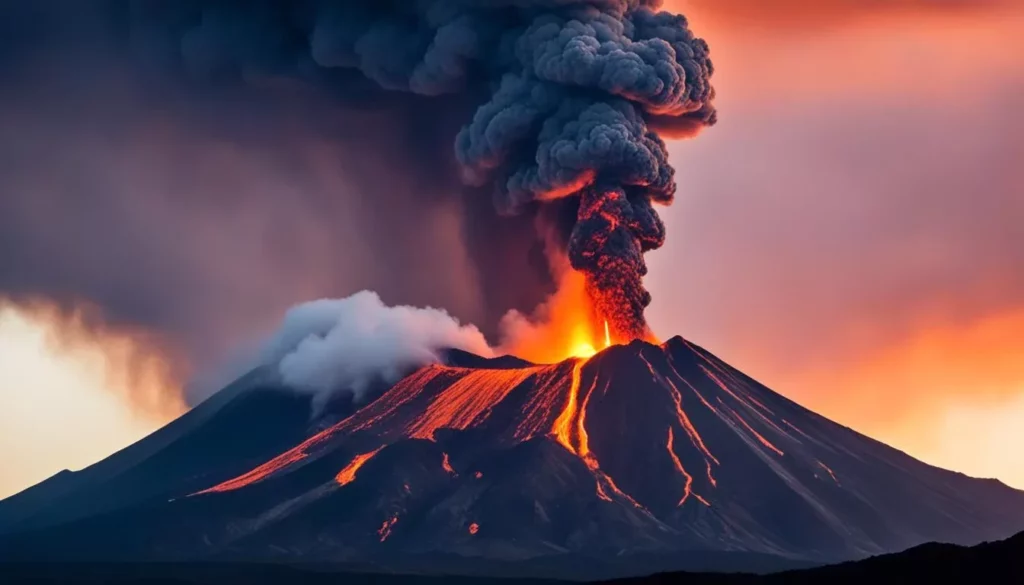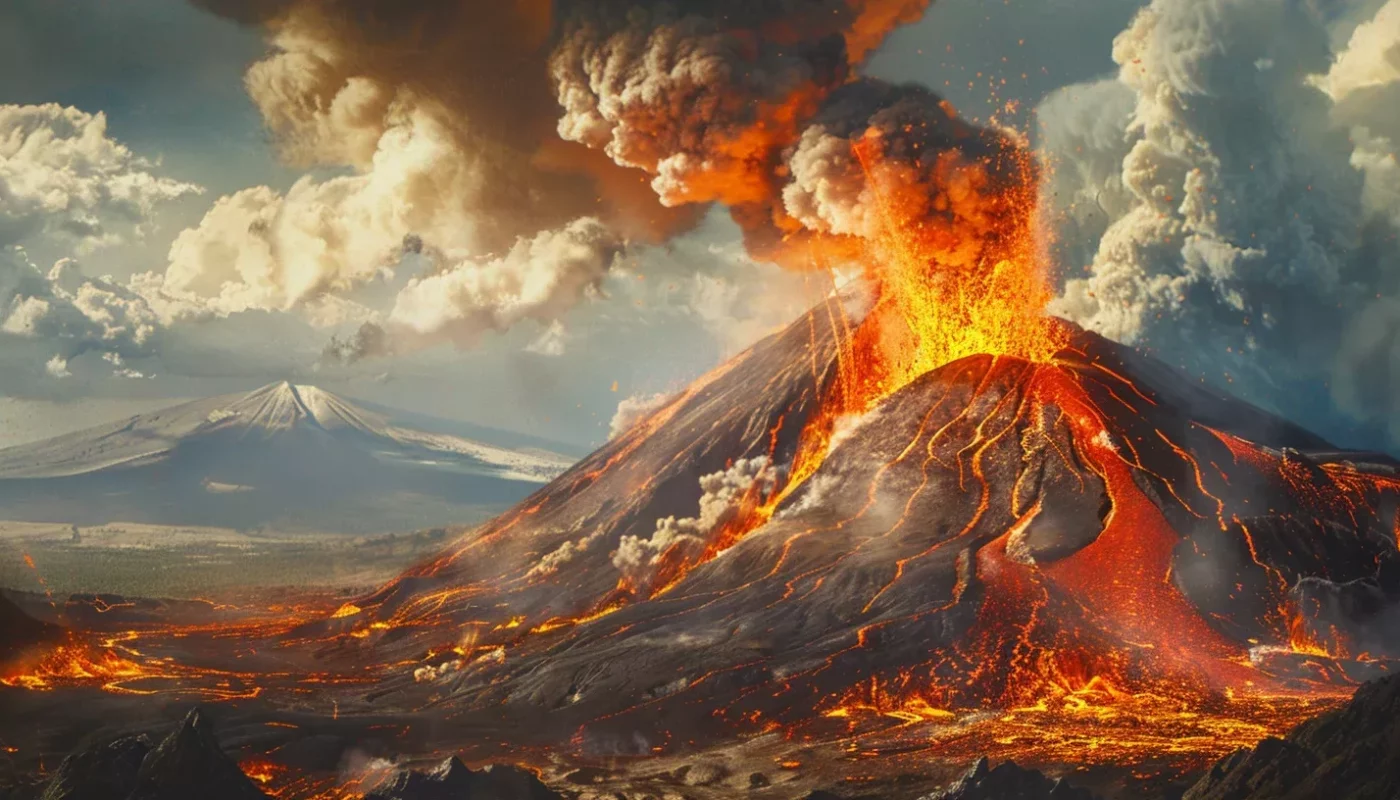Did you know the Parícutin Volcano in Mexico is one of Earth’s youngest volcanoes? It appeared suddenly in a cornfield in 1943. This event was more than a geological marvel. It showed the raw power of our planet, fascinating both scientists and locals.
Imagine seeing the Earth’s crust open and a sleeping volcano awaken. The birth of Parícutin was awe-inspiring. It changed the landscape and left a lasting mark on history.
In just a short time, this fiery mountain grew from a small crack to a large, smoking peak. It changed Michoacán’s landscape forever. The rise of Parícutin is an extraordinary story. It captivates geologists and explorers from all over. Stay with us as we tell you more about this incredible geological event.
Introduction to Parícutin Volcano
The Parícutin Volcano came to life in 1943. It showed the world a rare sight of volcanic activity. Located in Michoacán, Mexico, this wonder has amazed both scientists and the public.
What is Parícutin Volcano?
Parícutin is a cinder cone volcano that suddenly appeared in a Mexican cornfield. Its appearance and activity until 1952 gave deep insights into geology. It allowed a close-up study of volcanic activity from start to sleep.
Location and Geography
Parícutin is in Michoacán, a place with varied landscapes. It’s about 200 miles west of Mexico City. It’s a major landmark. The area has fertile plains and green forests. Parícutin’s presence makes Michoacán, Mexico, even more stunning.
Historical Significance
The appearance of Parícutin in 1943 amazed many. Locals in Michoacán saw Earth’s power up close. It changed their lives and land forever. This event helped study volcanic activity and showed how dynamic Earth’s geology is.
The Dramatic Arrival
On February 20, 1943, everything changed for the people in Michoacán, Mexico. This was when Parícutin Volcano burst into the scene. It captivated everyone with its sudden eruption. The ground under a cornfield in Parícutin village shook and split. This marked the start of a remarkable geological event.
The Day It Began
The eruption started one afternoon, with tremors shaking Parícutin. A crack opened, spewing ash and smoke within hours. Witnesses saw the earth rise and ash columns shoot into the sky. By evening, glowing lava flowed, lighting up the dark scenery and adding to the surreal atmosphere.

Local Witnesses’ Accounts
Locals give invaluable insights into Parícutin’s initial eruption moments. They describe loud earth rumbles and sulfur smells filling the air. Some felt the lava’s heat from afar. Others watched the new volcano grow, sending ash and gases skyward. These stories highlight the eruption’s immense power.
Initial Volcanic Activity
The Parícutin Volcano’s activity quickly intensified. It soon formed a cone, throwing out lava, ash, and rocks at a surprising speed. Scientists were amazed by its rapid growth, a rare event in modern times. The locals showed incredible resilience, quickly adjusting to the astonishing natural spectacle.
The Eruption Timeline
The Parícutin Volcano eruption was a grand event in the study of geology. It started small and grew to amaze the world. Let’s explore the journey of this incredible volcanic eruption from start to finish.
On February 20, 1943, Dionisio Pulido, a farmer, saw his cornfield’s ground crack. This was the start of Parícutin Volcano. Within a day, the volcano roared to life, spewing ash and lava upwards.
In its first year, Parícutin was mostly explosive. It formed a cinder cone that grew large. By June 1944, it unleashed its first big lava flow. This altered the area’s appearance drastically.
Here’s a table showing the key events of the Parícutin Volcano eruption:
| Year | Event |
|---|---|
| 1943 | Initial eruption with ash and cinder ejections |
| 1944 | First significant lava flow |
| 1947 | Peak volcanic activity with towering lava fountains |
| 1952 | Volcanic activity declines, leading to eventual dormancy |
By 1952, the volcano’s activity slowed down, ending the eruption. It left the volcano over 400 meters tall. Parícutin has changed the landscape forever and continues to fascinate people with nature’s might and mystery.
Geological Impact of Parícutin
The Parícutin volcano eruption changed its surroundings forever. It created new land and changed the way the area looks. This change continues to affect Michoacán, Mexico, in big ways.

Formation of New Land
The eruption made new land, changing the landscape a lot. Lava and ash made fertile ground, letting new plants and animals thrive. This shows how our planet’s crust is always changing.
Changes in Local Topography
The eruption changed the land shapes, making new hills and valleys. What used to be flat is now rugged. This affected how water moves in the area and changed the region’s look.
Long-term Effects on the Environment
The Parícutin eruption’s effects were both good and bad. The soil became richer, helping farms. But it also hurt the old environment at first. Over time, nature has bounced back, showing its strength and ability to adapt.
The table below highlights the key areas impacted by the Parícutin eruption:
| Impact Area | Details |
|---|---|
| New Land Formation | Lava flows and ash deposits creating fertile ground for new ecosystems |
| Changes in Local Topography | Altered landforms and water drainage patterns |
| Long-term Environmental Effects | Both beneficial nutrient-rich soils and initial ecosystem destruction |
Michoacán: The Setting of the Eruption
Michoacán lies in the west-central part of Mexico. It offers a beautiful background for the story of the Parícutin Volcano. Known for its culture and landscapes, this area got famous with the volcano’s sudden activity.
The eruption in Michoacán was a big change for the locals. The Parícutin Volcano appeared in 1943, changing the land and culture. This event is key in Michoacán’s history, making it stand out.
Michoacán’s varied nature set a stunning stage for the eruption. Parícutin came to life among farms, affecting farmers’ lives. Scientists and adventurers were drawn to this site to see a volcano grow and then go quiet.
The Parícutin Volcano made people see how powerful nature can be. For Michoacán’s locals, already rich in tradition, it became part of their story.
Now, the eruption site shows Michoacán’s strength and ability to adapt. The Parícutin Volcano’s tale is now part of the area’s story. It draws those who want to see its history and the lively nature around it.
Volcano Tourism: Visiting Parícutin
For those wanting to explore volcano tourism, Parícutin is a top choice. Located in Michoacán, Mexico, it offers stunning views and a fascinating history.
How to Get There
To start your Parícutin adventure, head to Michoacán. The closest big city is Morelia, with flights from many places. From there, drive or take a bus to Angahuan. In Angahuan, guides and horses will take you to the volcano.
Nearby Attractions
There’s more to see near Parícutin, too. Uruapan’s beautiful national park and waterfall are close by, perfect for nature lovers. Also, the historic city of Pátzcuaro is nearby, known for its culture and architecture.
Best Time to Visit
The best time to visit Parícutin is from November to March. The weather is cool and dry, ideal for hiking. Other months might have rain, making the paths slippery.
Whether you’re an eager explorer or just curious, Parícutin offers an experience you won’t forget.
Narratives from Locals
The eruption of the Parícutin Volcano changed local communities forever. People share stories that show their awe, fear, and strength. These stories give us a personal look at the volcano’s impact.
Dionisio Pulido’s fields were the first to feel the volcano’s wrath. His tale shows the shock of seeing his land split open, spewing smoke and ash. Villagers came together, amazed at the power of nature creating a new volcano.
“It was as if the ground was boiling and then suddenly, it gave way to a force beyond our control,” recalled Pulido. “We watched in fear and amazement as the land we knew changed forever.”
María from Angahuan watched lava threaten their homes. She tells how the community acted as one to save what they could. Her story highlights their collective strength during those scary times.
- Eruption shock: The sudden tremors and ash explosion caused fear and panic.
- Family efforts: Villagers, like María, describe how families moved their animals and belongings to safety.
- Community unity: Despite the chaos, people came together to help each other.
These stories create a clear image of life during the Parícutin eruption. They show the strong spirit of the people affected. Their resilience shines through, making their experiences with Parícutin unforgettable.
Parícutin vs. Other Volcanic Wonders
Parícutin’s emergence in 1943 fascinated locals and scientists worldwide. Comparing it with other famous volcanoes, like Mount St. Helens and Krakatoa, highlights its uniqueness. We get a clearer picture of Parícutin’s place in world volcanic activities.
Comparison with Mount St. Helens
Mount St. Helens in Washington State erupted in 1980. This eruption was sudden, unlike Parícutin’s gradual appearance. While people watched Parícutin grow, Mount St. Helens’ eruption caused immediate damage.
The power of Mount St. Helens sent ash flying, wrecking vast areas and changing weather far away. Parícutin and Mount St. Helens show how diverse volcanoes can be, each with its unique effects.
Comparison with Krakatoa
Krakatoa in Indonesia erupted in 1883, a major event known worldwide. Its explosion affected global weather, unlike Parícutin’s more local impact. Yet, Parícutin significantly changed Michoacán, Mexico.
After Krakatoa erupted, a new island called Anak Krakatoa formed. This showcases the enduring geological changes caused by volcanoes. By looking at these events, we appreciate their distinct and incredible nature.
Parícutin, Mount St. Helens, and Krakatoa are all unique volcanic events. Their varied eruption styles and impacts deepen our understanding of Earth’s dynamics. They show nature’s power and its lasting effect on our world and history.


